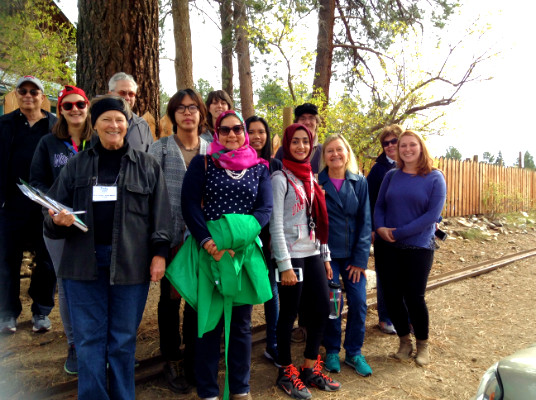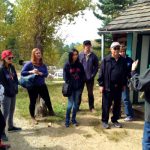Professor Feroza Jussawalla took her English 580 class, entitled “D.H. Lawrence & Sense of Place” up to Taos to the D.H. Lawrence ranch for a field trip for them to visit where Lawrence lived while he was in Taos, gain a better understanding of his associations with Mabel Dodge Luhan who was his “patroness”, and view his provocative paintings.
D. H. Lawrence, the author of literary classics such as Women in Love and Lady Chatterley’s Lover, and his wife, Frieda first came to New Mexico in September 1922 at the invitation of Mabel Dodge Luhan, a New York socialite and arts patron who lived in Taos. The trip was pivotal for Lawrence. While the English-born writer only spent a total of eleven months during his three visits to New Mexico, the state made a notable impression on him.
In March 1924, Lawrence and his wife, accompanied by Dorothy Brett, an English painter and admirer of the author, returned a second time to Taos. On this visit, Mabel Dodge Luhan gave Frieda a ranch she owned located 20 miles northwest of Taos on Lobo Mountain. The 160 acres was known as the Kiowa Ranch because the Kiowa Indians had used a trail which ran through the property when they traveled south to raid Indian pueblos along the Rio Grande.
Lawrence and Fried, along with Lady Brett, who was the Earl of Esher’s daughter, moved to the ranch in May 1924 and spent five months there. During the summer, Lawrence completed his short novel “St.Mawr” in which he celebrates the special quality and landscape of the Kiowa Ranch. Lawrence also wrote his biblical drama, “David” and parts of “The Plumed Serpent” during his last visit to the ranch from April to September in 1925. New Mexico also figures prominently in other essays and stories, such as, “The Woman Who Rode Away.”
After Lawrence died near Vence, France in 1930, Frieda returned to New Mexico to live. Four years later, she had Lawrence’s body exhumed, cremated and his ashes brought to the ranch to be housed in a small memorial chapel. In 1955, eight months prior to her death, Frieda gave the Kiowa Ranch to the University of New Mexico. She stipulated that the ranch be used for educational, cultural and recreational purposes and that the Lawrence memorial be open to the public. Since then, the ranch has been known as the D. H. Lawrence Ranch.
- Group of both graduate and undergraduate students who attended
- A cabin on the Ranch
- Graduate Stuent and Alumna, Lynn Karaczor at D.H. Lawrence Ranch
- Dorothy Brett’s Cabin
- Students listening to Docent at the D.H. Lawrence Ranch
- A cabin on the Ranch















